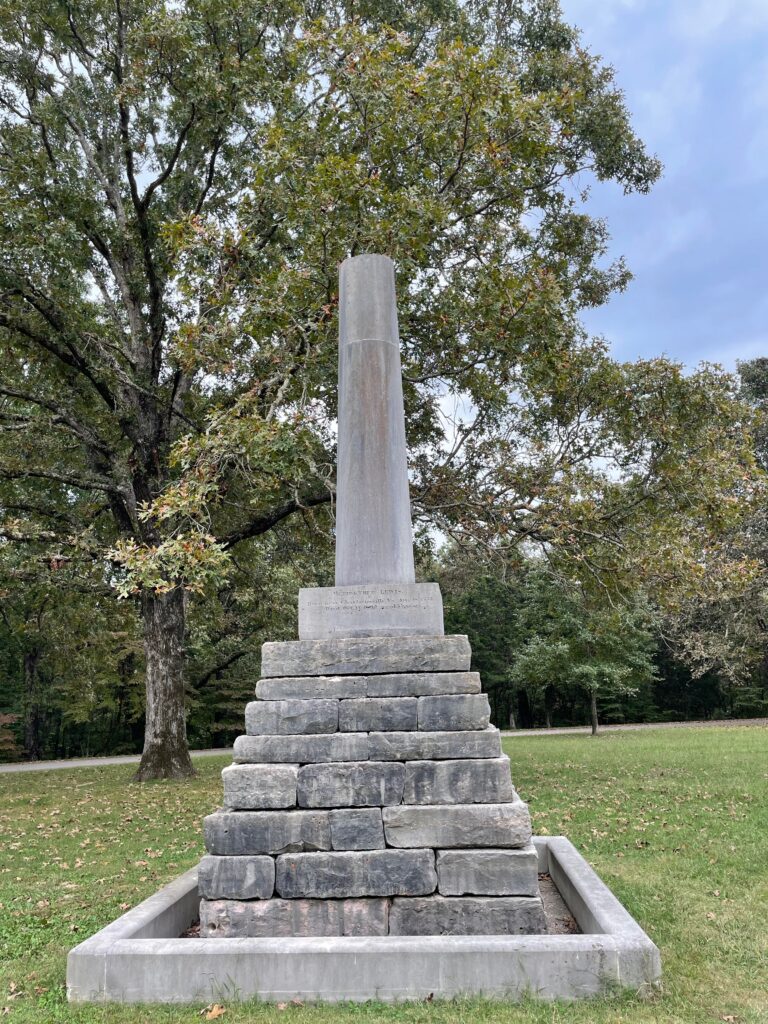Erik Visits an American Grave, Part 1,392
This is the grave of Meriwether Lewis.

Born in 1774 on a plantation near present day Ivy, Virginia, Lewis spent his first years in the Virginia slaver elite. His father died in 1779, his mother remarried, and the family moved to the Georgia frontier. Lewis never saw a school until 1787. Still had the slaves though! He was big into the outdoors, got to know some Cherokee, learned a lot about animals and wild plants, and developed a serious interest in the outdoors. It was to send him to school that he ended up back in Virginia. There he had access to good education, though he never went to college. Not so surprising there for that given place and time. This was not Massachusetts after all.
Lewis joined the Virginia militia and was sent as part of the forces to put down the Whiskey Rebellion in Pennsylvania in 1794. He joined the Army the next year and rose fairly quickly in that small force. He became a captain in 1800 and served under a guy named William Clark, brother of the explorer and less than great guy George Rogers Clark. Lewis resigned in 1801 to be an aide to Thomas Jefferson, who had taken a liking to the young Virginian, originally from his area. He was appointed as Jefferson’s secretary.
So when Napoleon sold the middle of North America to the United States for a hill of beans, Jefferson naturally wanted to know what was out there. The president was always interested in natural history and the animals of the North American continent. Plus he hoped to discover a Northwest Passage. Thus, the Lewis and Clark Expedition.
Lewis and Clark made a good team. Again, Lewis had served under him. Clark was a long time western man and Lewis was the natural historian Jefferson wanted. Now, there’s no way to discuss the Lewis and Clark Expedition without noting that the entire purpose was to expand power and subjugate Native Americans before other European powers could get there first. In fact, there was already plenty of European presence in these places through trade goods. Fur traders had been out there before them and even where they hadn’t, the goods procured on the coasts had made their way inland via indigenous trading networks. So it wasn’t like people were that shocked when a bunch of white guys showed up.
Now, Lewis is a lot more interesting than Clark, who was a genocidal lunatic. But that was not the goal of this mission. The goal was science (well, secondarily) and expanding American empire. So they stayed peaceful and relied on the tribes, especially the Mandan, who housed them over the first winter when they ended up in modern North Dakota, not exactly a great place to spend a winter without help. Lewis was collecting stuff the whole time and sending it down river to Jefferson–plants and written observations, but especially animals, live if possible. Lewis also had his own history of interaction with the tribes and unlike Clark and most of the others on the mission, those had tended to be pretty good. So sending him out there with an understanding of how to get along with the tribes made him a valuable person to co-lead the expedition.
Interestingly, for all people talk about Lewis and Clark today, that was not the case in the 19th century. It received very little attention from Americans until well into the 20th century, mostly after World War II. Of course, today it is one of the iconic moments in American history, even getting a very boring Ken Burns documentary. In any case, they returned successfully in 1806 after a miserable second winter on the Oregon coast, which they loathed way worse than North Dakota. As an Oregonian, I’ve always found this amusing.
Jefferson paid Lewis off with land and an appointment as governor of Missouri Territory for his contributions. But….he wasn’t a very effective administrator. Lewis suffered from crippling depression and this made a lot of things about an administrative job difficult. He fought with people all the time and could be quite indecisive. Moreover, after his constant battles with subordinates got him in trouble with the American government (regardless of the disputed truth of these allegations), the government not only refused to pay Lewis back for expenses he had fronted for a mission back to the Mandan, his creditors pounced and eventually he lost his land grant and had his assets liquidated.
In 1809, Lewis set out to DC to deal with all this fallout. He didn’t make it because he shot himself at an inn in Tennessee. Occasionally people want to prove that it was murder, I have no idea why, but even they have to admit that he had already attempted suicide shortly before, so it doesn’t seem like much of a case to me. More broadly, like, oh say the Titanic, I have no idea why people get so worked up over some famous person or boat wreck to the point they go to ridiculous lengths to prove the greatness of the person/risk their life to see it. In any case, Lewis was 35 years old.
Meriweather Lewis is buried at the Meriwether Lewis Monument, Hohenwald, Tennessee.
If you would like this series to visit other members of the Lewis and Clark Expedition, you can donate to cover the required expenses here. William Clark is in St. Louis. We don’t know where Sacagawea is and in fact her story is a lot more unknown but also more interesting than either Lewis or Clark. Historians still attempt to discover tidbits about her life, though it is difficult. We don’t know where York, Clark’s slave, is either. Patrick Gass, who was the first to publish his journal about the expedition and the last to die, is in Wellsburg, West Virginia. Previous posts in this series are archived here and here.


